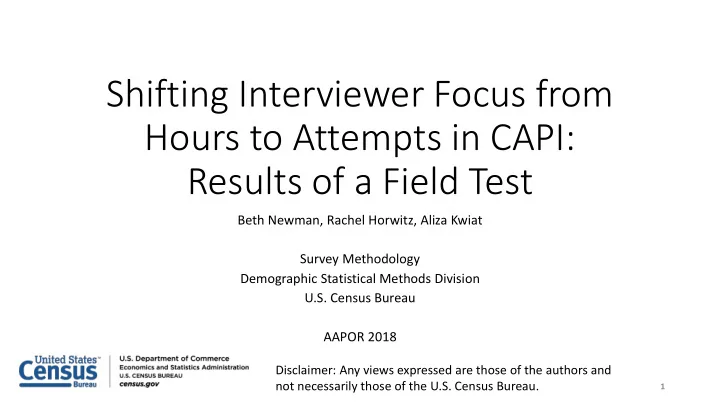

Shifting Interviewer Focus from Hours to Attempts in CAPI: Results of a Field Test Beth Newman, Rachel Horwitz, Aliza Kwiat Survey Methodology Demographic Statistical Methods Division U.S. Census Bureau AAPOR 2018 Disclaimer: Any views expressed are those of the authors and not necessarily those of the U.S. Census Bureau. 1
Shifting Focus Motivation • No contact attempt limit • Increase control over how cases are worked • Hour limit arbitrary • Implement scientific protocol • Reduce costs 2
Previous Research • Truncated data by contact attempt • Examined weighted estimates • Potential to limit contact attempts to 11 or 13, without significantly changing response rates or key estimates, respectively 3
Field Test Goals Observe if contact limit of 12 transferred well to field • Impact on response, key estimates • Challenges from procedural changes 4
Field Test Constraints • Risk • Cost • Limited IT functionality 5
Field Test Selection • Nonrandom design • Regional Offices: Atlanta, Chicago, Denver • Primary Sampling Units (PSUs): low CATI, low vacancy • Machine learning: clustering PSUs • 2010 frame data • 4,600 Households in treatment and control 6
Limitations • Nonrandom, no weights • 2010 frame data out-of-date • Noncompliance • Some interviewers thought 12 attempts was the goal, not the maximum 7
Evaluation Measures • Response and retention rates • Respondent/non-respondent demographics • Frequencies and R-indicators • Four key estimates • Interviewer behavior • Interviewer feedback 8
Four Key Estimates • Percent Reporting Unemployment • Employment to Population Ratio • Percent of Persons Not in the Labor Force • Percent of Persons Employed Part-time for Economic Reasons 9
Comparison Method Permutation Tests • Generate reference distribution for test statistics • No larger population assumptions • Calculate two-sided t-statistic 10,000 times 10
Comparison Method, Permutations 11
Response Rates Unweighted Response Rates Groups Response Rate (Percent) Treatment 87.31 Control 86.06 Non-treatment (Control + Remaining CPS sample) 86.44 12
Demographic Comparisons 13
Previous Month Comparisons 14
Estimate Differences Over Time Proportion Unemployed Unweighted 2017 Percentage Point Difference Treatment and Control Treatment and Non-treatment 1.00 0.50 0.00 -0.50 -1.00 -1.50 May June July August September October 15
Conclusions Shifting from hours to contact attempts No influence: • Response or retention rates • 3 of 4 key estimates • Respondents demographics • Interviewer behavior and costs 16
Beth Newman Survey Methodology Demographic Statistical Methods Division U.S. Census Bureau beth.newman@census.gov 17
Recommend
More recommend